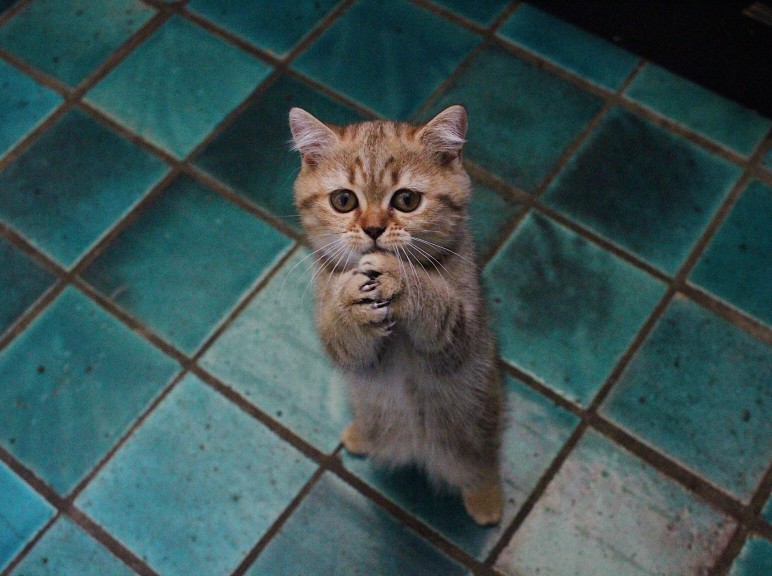The Origin of Cat Meowing
First, it’s important to understand where your cat’s meowing comes from. Like many of our pets’ behaviors, the cat’s meow has deep roots in their history and evolution. To understand why your cat meows, it’s useful to explore this past.
The evolution of a cat’s meow
A common belief is that meowing is a natural means of communication for cats. However, this is a misconception. On the contrary, researchers in the field of animal ethology have discovered that meowing is actually a form of communication that cats have developed specifically to interact with humans. By observing interactions between feral cats, the researchers found that they use a largely non-verbal communication system, based mainly on facial expressions, body postures and territory marking. But when cats interact with humans, they use a variety of sounds, including meowing, to express their feelings and intentions.
Different types of meowing
Now that we have an idea of the origin of this means of communication, let’s delve into the nuances of cat meowing. It’s fascinating to note that cats have an incredibly diverse range of meowing sounds, from a simple meow, similar to a greeting, to a loud howl signaling discomfort or distress. In this section, we’ll teach you how to understand and interpret these different types of meows – a skill every cat owner needs to acquire to best meet their feline’s needs.
Interpreting your cat’s meows
Understanding hungry meows
First, let’s talk about the hungry meow. This is probably one of the easiest to identify for most cat owners. As a general rule, it’s characterized by insistent, repetitive meowing, often accompanied by additional behaviors such as rubbing against your legs and repeatedly pointing towards where the food is. By interpreting these signals correctly and responding appropriately, you can satisfy your cat’s nutritional needs quickly and efficiently.
Meows for attention or cuddles
Another common type of meow is one that expresses your cat’s desire for attention or a cuddle. This meow can vary in intensity and length depending on the individual, but is generally softer and more melodious than the hunger meow. It’s often followed by other behaviors such as gentle head butts against your hand or intense stares. Responding to this meowing with petting, affection or play can strengthen the relationship between you and your cat, and contribute to her general well-being.
Identify meows related to stress or discomfort
Finally, it’s crucial to know how to recognize meows associated with stress or discomfort. These meows may seem sharper, louder or more insistent than usual. They are often accompanied by behaviors such as restlessness, extended claws, rapid breathing or escape attempts. Identifying the signs of stress in your cat and knowing how to respond to them can contribute greatly to its quality of life and mental health.
Solutions to meet your cat’s needs
How to respond to hungry meows
Providing quality food in adequate quantities is essential to maintaining your cat’s good health. In general, we recommend giving your cat several small meals a day (usually 3-4) rather than one or two large meals. This approach helps prevent obesity, which can lead to many other health complications, and also mimics the natural behavior of cats, which are opportunistic hunters with a tendency to eat small meals throughout the day.
Tips for giving your cat attention
To meet your cat’s demands for attention, try to devote time every day to interactive activities such as playing and petting. Remember that every cat is unique and may have its own preferences for interaction. Some cats prefer long cuddling sessions, while others thrive on high-energy, interactive play. Be patient, observe your cat’s reactions carefully and adapt to its individual preferences for quality time together.
How to calm a stressed cat
If your cat seems stressed or anxious, there are various techniques you can try to help calm her down. In the event of distress meows, it’s important to respond calmly and patiently. Trying to understand the stress factor and, if possible, eliminating the cause of the stress is crucial. If stress is caused by an overly noisy or busy environment, for example, giving your cat a quiet, secure space can help a lot.
The Cat’s Meow: a language to tame
Now that you know more about the origin, different types and possible interpretations of your cat’s meow, you’re well equipped to deepen your relationship with your feline. Every meow is an opportunity to communicate with your cat and meet its needs in the best possible way. So enjoy every meow, purr and moment you share with your favorite feline, and remember that every moment spent together strengthens the unique bond between you.




